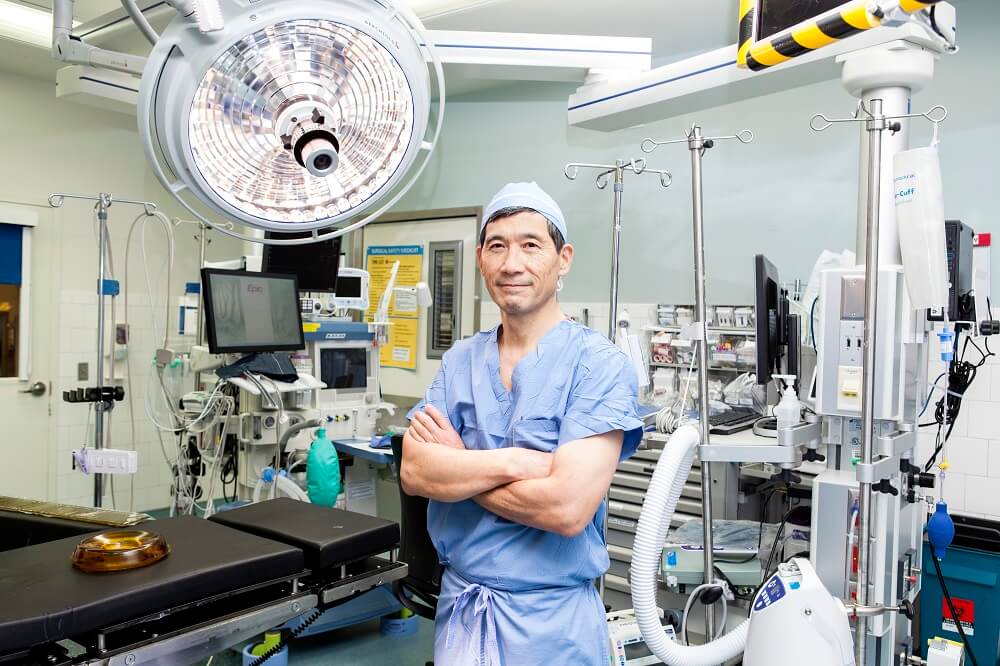Tanabe Lab
Contact Information
Tanabe Laboratory
Surgical Oncology Research Laboratory
Phone: 617-726-7735
Email: ktanabe@partners.org
Explore This Laboratory
About Dr. Tanabe

- Co-chief, Division of Gastrointestinal and Oncologic Surgery, Massachusetts General Hospital
- Surgical Director, Melanoma Center/Pigment Lesion Clinic, Massachusetts General Hospital
- Professor of Surgery, Harvard Medical School
- Deputy Clinical Director, Mass General Cancer Center
Research Projects
Herpes Simplex Viral Oncolysis
The Tanabe Lab focuses its studies on hepatobiliary cancer. Viruses used for gene therapy applications have generally been engineered to prevent viral replication in humans and deliver transgenes to achieve a therapeutic benefit. However, replication-conditional viruses may be exploited for cancer gene therapy because viral replication within cancer cells results in their destruction (viral oncolysis). Our laboratory research has focused on developing viruses that destroy cancer cells preferentially. We have developed several animal tumor models to enable us to study viral oncolysis of diffuse liver metastases. In initial proof-of-principle experiments, we studied HSV-1 mutants defective in expression of the large subunit of viral ribonucleotide reductase (ICP6) and are thereby markedly attenuated in normal cells. Importantly, overexpression of cellular ribonucleotide reductase functionally complements the absence of its viral counterpart to allow lytic viral replication to proceed in infected cells. Analysis of resected human liver tumor specimens reveals that cellular ribonucleotide reductase levels are extremely low in normal liver yet markedly elevated in liver metastases. Accordingly, titers of ICP6-defective HSV-1 infectious progeny recovered after infection of colon carcinoma cells are two to three log orders higher than those recovered after infection of hepatocytes.
ICP6-defective HSV-1 mutants replicate selectively in liver metastases rather than normal liver following vascular administration into the liver. This replication is cytolytic and significantly reduces liver tumor burden. Studies in immune-deficient mice reveal that the magnitude of viral replication correlates with the anti-neoplastic efficacy, and host immune responses are not the primary mechanisms of tumor destruction.
We have constructed several replication-conditional HSV-1 mutants for both therapeutic transgene delivery and oncolysis of liver tumors, and we have characterized antagonistic and synergistic interactions between the viral lytic cycle and expression of therapeutic transgenes, such as yeast cytosine deaminase, rat cyp2B1, and murine endostatin. We have also developed HSV-1 mutants in which genes important for viral replication are regulated by tumor-associated promoters (e.g. CEA, MUC1).
Development of methods for non-invasive, realtime monitoring of sites of HSV-1 infection is important for conduct of clinical trials with HSV-1. We have examined use of HSV-1 thymidine kinase as a reporter for positron emission tomography. [18F]-FHBG is phosphorylated specifically by HSV-1 thymidine kinase (and not mammalian thymidine kinase), upon which it is trapped intracellularly and emits positrons. An Investigational New Drug (IND) application will be submitted in 2008 to conduct a Phase I clinical trial of an HSV-1 mutant developed at Mass General for treatment of primary and secondary liver tumors.
Epidermal Growth Factor and Hepatocellular Carcinoma
Mounting evidence supports a role for epidermal growth factor (EGF) in malignant transformation and tumor progression. EGF induces transformation to anchorage-independent growth and enhances in vitro growth of human epithelial and mesenchymal-derived tumors. Transgenic mice with liver-targeted over-expression of the secreted EGF fusion protein develop hepatocellular carcinoma (HCC). We have assessed the relationship between human EGF gene single nucleotide polymorphism (SNP), EGF expression, and risk of HCC.
We have determined that the EGF 61*G allele is associated with greater transcript stability and EGF expression in HCC cell lines and primary cultures of human hepatocytes. Serum and liver EGF levels are higher in individuals homozygous for the 61*G allele relative to those homozygous for the 61*A allele. Analysis of the distribution of allelic frequencies revealed that the G/G genotype is significantly associated with risk of HCC (odds ratio 4.0; 95% CI 1.6, 9.6; p = 0.002) relative to the A/A genotype in a case-control study of 207 Massachusetts General Hospital patients with cirrhosis. Logistic regression analysis demonstrates that number of copies of G is significantly associated with risk of HCC after adjusting for age, gender, race, etiology, and severity of cirrhosis (G/G or A/G versus A/A hazard ratio 3.49; 95% CI 1.29, 9.44; p = 0.014). We have validated this important observation in a cohort of French patients with alcoholic cirrhosis and HCC.
Thus, EGF SNP genotype is associated with risk for development of HCC in liver cirrhosis through modulation of EGF levels. Measurement of serum EGF levels may be useful to assess risk for HCC in cirrhotic patients. We will continue to examine the EGF pathway as a target for chemoprevention strategies in cirrhotic patients at high risk for HCC.
Publications
Group Members
- Director: Kenneth K. Tanabe, MD
- Group Members
- Bryan Fuchs, PhD
- Darshini Kuruppu, PhD
Contact Us
Research topics in the Tanabe Lab include hepatobiliary cancer, epidermal growth factor and hepatocellular carcinoma.
